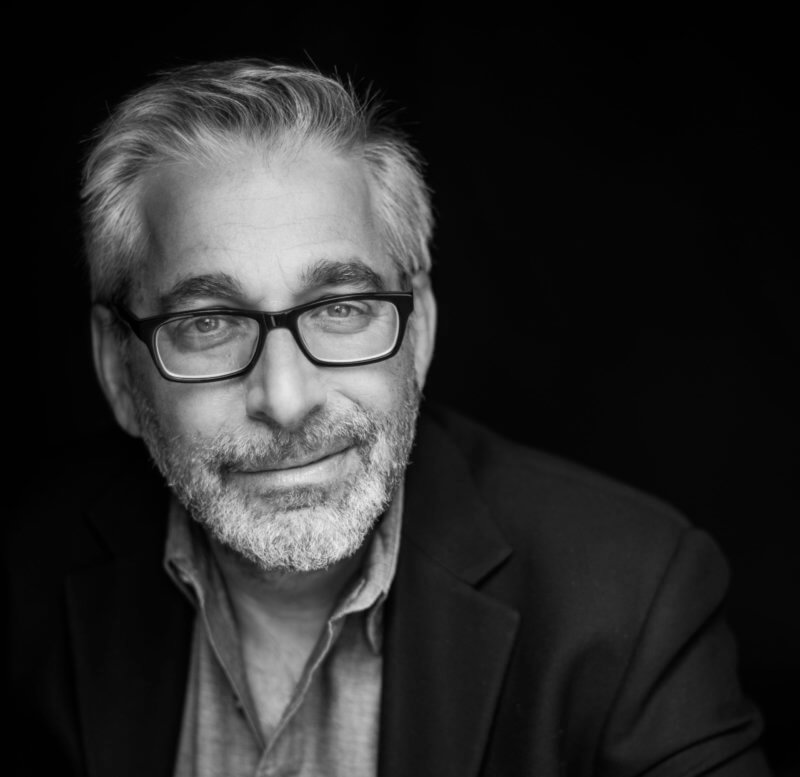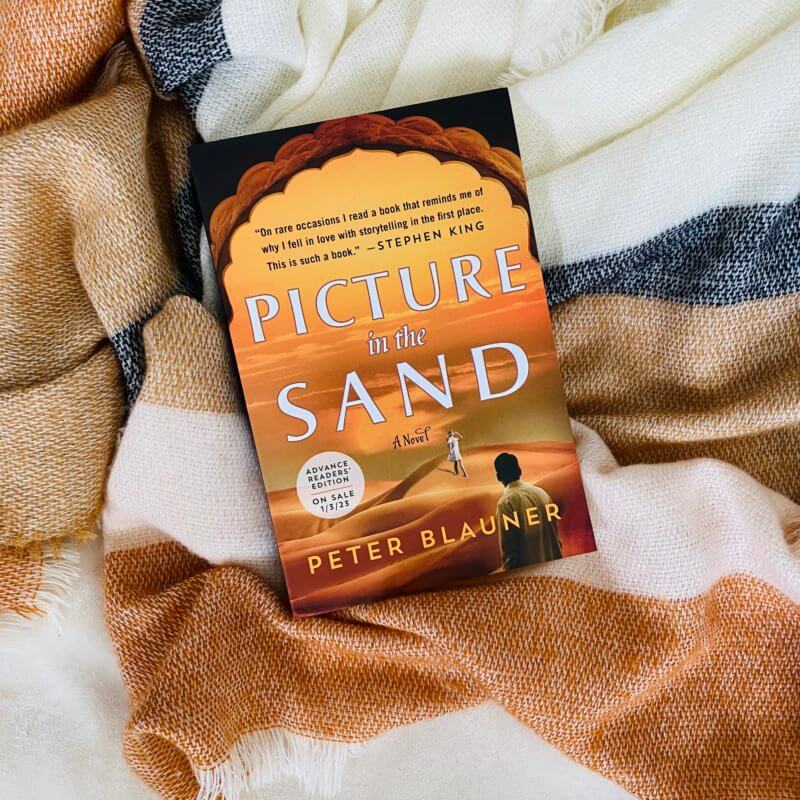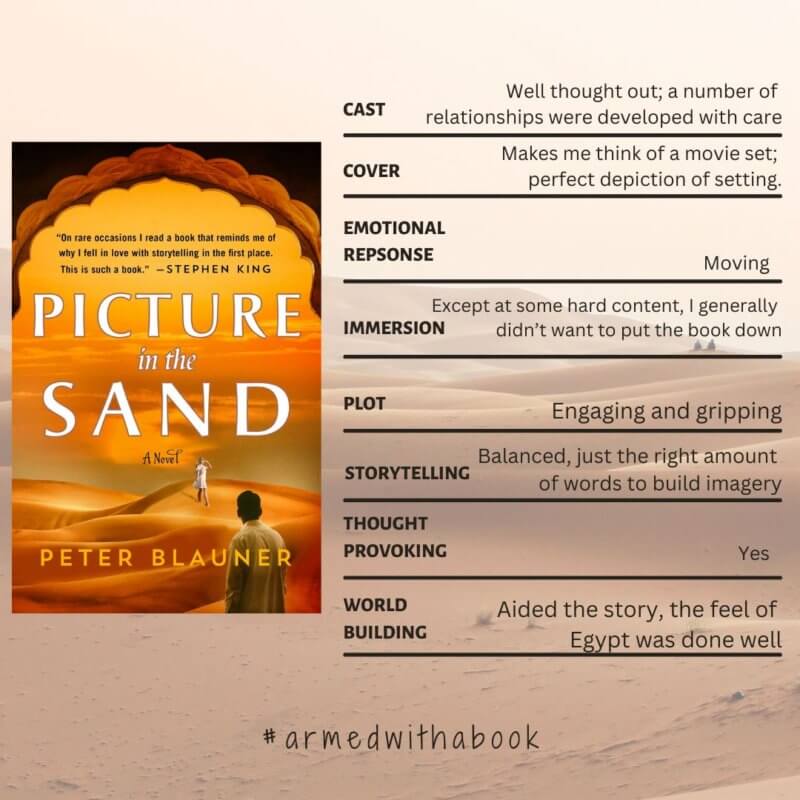Welcome, friend! Yesterday, I shared how much I enjoyed Peter Blauner’s Picture in the Sand. I am excited to have been able to connect with him and bring this interview to you. 🙂 Let’s do a quick review of what the book is about:
Picture in the Sand
by Peter Blauner

Peter Blauner’s epic Picture in the Sand is a sweeping intergenerational saga told through a grandfather’s passionate letters to his grandson, passing on the story of his political rebellion in 1950s Egypt in order to save his grandson’s life in a post-9/11 world.
When Alex Hassan gets accepted to an Ivy League university, his middle-class Egyptian-American family is filled with pride and excitement. But that joy turns to shock when they discover that he’s run off to the Middle East to join a holy war instead. When he refuses to communicate with everyone else, his loving grandfather Ali emails him one last plea. If Alex will stay in touch, his grandfather will share with Alex – and only Alex – a manuscript containing the secret story of his own life that he’s kept hidden from his family, until now.
It’s the tale of his romantic and heartbreaking past rooted in Hollywood and the post-revolutionary Egypt of the 1950s, when young Ali was a movie fanatic who attained a dream job working for the legendary director Cecil B. DeMille on the set of his epic film, The Ten Commandments. But Ali’s vision of a golden future as an American movie mogul gets upended when he is unwittingly caught up in a web of politics, espionage, and real-life events that change the course of history.
It’s a narrative he’s told no one for more than a half-century. But now he’s forced to unearth the past to save a young man who’s about to make the same tragic mistakes he made so long ago.
Content notes include torture, imprisonment, racism, and violence.
Hi Peter. Welcome to Armed with A Book! 🙂 Please tell me and my readers about yourself.

I’m just a guy from the city who loves reading and writing. And I’ve been lucky to make a living out of it for forty years – as a journalist, a TV writer, and – most important, to me – as a novelist.
Picture in Sand is a brilliant book and I loved the setting of an American movie backdrop being shot in Egypt. What came first for you — the plot or the characters? What was the most difficult part of your writing process?
Ha! All of it was the most difficult part, because I made it that way!
Seriously, I knew it wasn’t going to be easy because I’d never undertaken a project like this before. All my other books were crime novels, set in or around New York City, in the present. When I got the idea for PICTURE IN THE SAND, twenty-one years ago, I thought it was a once-in-a-lifetime story – putting together a famous Hollywood movie Bible with a moment in Middle Eastern history that led to 9/11. I knew it would have a mixture of famous real-life people like Cecil B. DeMille and Gamal Abdel Nasser and characters I just made up in my head. And I knew I had to make a good faith effort to understand a smidgen about Egypt and its history, because there are so many people who know so much than I ever will.
So the hardest part was figuring out who would get to tell the story and why a contemporary reader should care about these things that happened in 1954. In the back of my mind, I knew Ali was the right choice to be the narrator, but I also knew it was risky from both a commercial and political point of view. Then I remembered something important. If you’re not breaking some kind of rule, you’re not worth a damn as a writer. So I went ahead and did it.
You travelled to Egypt a few times for this book. Tell me about researching for Picture in the Sand.
I went to Egypt six times, including a month during the Arab Spring on 2011. And I went to Hollywood at least six times, to interview people who’d worked on THE TEN COMMANDMENTS. Needless to say, Egypt has an amazing history and I was very fortunate to find a lot of people who were generous with their time and insights. I talked to quite a few people who worked on the film – from Nina Foch, who played the mother of Moses, to Mona Sergaldin, whose father was the Egyptian architect who built the sets in the deserts outside Cairo. I visited the places where DeMille shot, near the Red Sea and on Mount Sinai. I also talked to people in Egypt who knew the history first-hand, like Gamal al-Bana, whose brother Hasan founded the Muslim Brotherhood. But the people who helped me the most were Cecil B. DeMille’s grandchildren, who were actually there in Egypt when the movie was being made and had lots of great stories to tell.
Had you seen THE TEN COMMANDMENTS before diving into writing this book? Did your perception of the movie change as you learned more about its production?

I’m a bit of a movie buff, if not an expert of any kind, but I had only seen the end of THE TEN COMMANDMENTS with the parting of the Red Sea sequence until March 27, 2002. On that night, just a half-year after 9/11, I was hanging around before somber family holiday dinner and I happened to catch the opening credits. That’s how I learned part of the movie was shot in Egypt. Because 9/11 had been so recent – and because I’d been a journalist – I knew the roots of that attack went back to Egypt in 1954, when the new military junta jailed members of the Muslim Brotherhood and further radicalized them through torture. All of a sudden, I realized DeMille and Charlton Heston were there, in the middle of this turmoil. As I started to research it, I got even more intrigued.
One of the first things I learned was that Cecil B. DeMille had initially trying to get King Farouk to sanction the production. But by the time, DeMille was ready to go over and shoot, Farouk had been deposed and replaced by one General Mohammad Naguib. But when DeMille and his associate producer Henry Wilcoxon arrived, they were told President was no longer available, i.e. he was under house arrest. Instead, they were led into a meeting with Prime Minister Nasser. At first, the meeting seemed to be going badly because Nasser ignored DeMille and was speaking mainly to Wilcoxon, as there was confusion about who was in charge. But then it turned out Nasser remembered that Wilcoxon had been an actor and had played Richard the Lionhearted in a film called The Crusades. The movie had been a dud at the box office, but Nasser loved it and, for some reason, loved Wilcoxon’s rather stiff performance. Of course, that scene is in PICTURE IN THE SAND, but like other things in the book it’s based on what actually happened.
If you could see one scene of THE TEN COMMANDMENTS enacted live, what would it be?
At first, I was going to say the parting of the Red Sea, but I remembered that it’s actually about seven different pieces of film from seven different locations that were put together with special effects in post-production. From working in TV, I know those kinds of scenes can be pretty lackluster “on the day.” Instead I’d liked to have been there for the massive Exodus with 15,000 Egyptian villagers playing the escaping Hebrews and 15,000 animals being heard between the sight lines. Just the smell must have been unbelievable. No computer simulations in those days! Again, it’s a scene that’s crucial in the novel, because of what happens to some of the major characters in it. But one of the most dramatic parts is absolutely true. I wouldn’t have had the nerve to include it otherwise.
Which of the characters do you relate to the most and why?
There’s a funny thing that happens when I write these novels. I always think the main character is going to be the one who most resembles me from the outside. In PICTURE IN THE SAND, there’s a cynical Jewish documentary filmmaker named Raymond Garfield, who’s shadowing Cecil B. DeMille, while also caught up in intrigue involving a young woman and off-screen political conspiracies. In the current climate, especially, you’d think I’d stick to writing from that guy’s point of view because I should “identify” with him.
But fiction doesn’t always work that way. If you’re only seeing things through a familiar set of eyes, you’re sometimes missing the whole story. Raymond turned out to be one of those characters who gets bigger when he’s gone more often. Instead, Ali became my guy. He’s the little dude caught up in bigger-than-life events, just trying to survive and carve out a decent life for himself against all odds. And I think that’s what most of us are like. At any rate, that was the point of view I could identify with in trying to describe big history-altering moments like the Egyptian Revolution, the career of Cecil B. DeMille, and the long runway to the current state of international tensions. I’m not an expert in any of those things. All I really know is how the characters I’ve made up will feel about these seismic changes.
The great newspaperman Jimmy Breslin used to have a saying about “look for the gravedigger.” Because right after John F. Kennedy was assassinated, everyone else wrote about his legacies and the possible conspiracies. But Breslin found the guy who was actually digging the grave. And his piece about that digger is the one we remember.
I quite enjoyed Alex and Ali as focal points for driving the narrative. Was there a particular reason why you chose to explore the grandfather-grandson relationship?
The question with any historical novel is: Why am I reading this story now? So it was crucial to make this dialogue between past and present, for readers to understand that. At a literal level, it’s a cautionary tale. Alex the grandson runs off to be a holy warrior instead of going to the Ivy League college he’s accepted to, because he feels in his heart that’s his true destiny. When he won’t respond to anyone else, his boring old grandfather, who owns a gas station in Brooklyn, says listen, kid, I’ve seen this movie before and I know how it ends. Because I lived it. And in telling that story from the past, Ali the grandfather not only offers a cautionary tale to his grandson, he shares his very personal view on a piece of history. For me, that answered the “why now?” question that I’d been asking myself for two decades.

What is a significant way Picture in the Sand has changed since the first draft?
I’m not going to tell you how many drafts there were in the twenty years I worked on the book, because I lost track of them myself. There were a number of different main characters and narrators who came and went. The idea of framing it as a kind of epistolary novel with emails between the grandfather and the grandson only came up during the pandemic. And the reason is that Covid made it impossible to do the kind of first-hand research I need to write a contemporary novel. Instead I turned back to PICTURE IN THE SAND, which I had basically given up hope on after many dead-ends and rejections. I just decided that I didn’t want to quit after all, that I had one more way to try to tell the story, and I didn’t care if anybody else read it, I was going to see the book through to the end no matter what. So I’m just glad it’s between two covers now, where people might eventually discover it.
How did you celebrate when you finished this book?
I’m still sort of quietly celebrating. As you might imagine, you get a pretty thick skin after twenty years. So it takes a while for sensations to sink in. But that’s okay. It makes it more meaningful when you hear from individual people who really read the book and got into it. Because that’s what it’s really about for me. The money comes and goes, and you can’t do anything about reputation in the long run. But if you really connect with someone through a story you’re telling, that’s the great achievement.
You have written a number of books in your writing career so far. Do you have a favorite?
The cliché is picking your favorite of your own books is like favoring one of your children. Obviously, PICTURE IN THE SAND is a novel with great personal meaning for me. I’ve been working on it for a third of my life. On the other hand, you never forget your first one. In my case, that was a crime novel called SLOW MOTION RIOT. I spent six months as a volunteer probation officer researching it. But somewhere in the middle, I published a crime novel called SLIPPING INTO DARKNESS. And that’s the one where I felt like all the elements of plot, character, texture and prose came together in a way that I was happy with.
How is Picture in the Sand different from your other works?
All my other novels are contemporary crime novels that are intended to reflect the time in which they were written. PICTURE IN THE SAND is an historical suspense novel about real life events that took place in Egypt in 1954, including the country’s revolution, the battle between its military leaders and religious fundamentalists who wanted control of the country, and the making of Cecil B. DeMille’s famous movie, THE TEN COMMANDMENTS. Those are all subjects other people know a lot more about than I do. But I had to make a good faith effort to do my research. As I mentioned, it took twenty years of researching, including six trips to Egypt and six to Hollywood, before I felt I could begin to get my arms around it. And then even more time to figure out what the right way to tell the story. Or more accurately, who should should the one telling it.
What kind of books do you like to read? What book (or books) are you currently reading?
I like any story that gives me a different way of looking at the world. The last novel that did for me was BAMBI. Yeah, that Bambi – the one the Disney cartoon is based on. The 1923 novel by Felix Salten is a whole other ballgame. It’s beautiful and brutal, and the Nazi saw enough political allegory in it to ban it. I’d recommend a wide range of readers. Except maybe not very young children. They’re not ready for something this tough-minded.
What are some books you would recommend to readers who loved Picture in the Sand?
The novels of Naguib Mahfouz, the Egyptian author who won the Nobel prize for literature. Especially the Cairo Trilogy, which spans the period World War I and World War II. He’s a terrific writer and I learned a lot about the Egypt from reading his books. I was also fortunate enough to meet before he died. He said two things I’ll always remember. He said, “I learned more from the near-great than the great.” Which is interesting. And the other thing he said was in response to a question I had about the country’s late leader Gamal Abdel Nasser. Mahfouz was quite frail at the time and would be dead within a year. He listened to my question carefully, nodded and answered in a raspy voice. “I don’t know the answer, but when I see him I’ll ask him.”
Thank you so much for your time, Peter! I have had a wonderful time reading Picture in the Sand and connecting with you.
Thank you for hanging out with Peter and me. Connect with Peter on Instagram, Facebook and his website.
Add Picture in the Sand to your TBR on Goodreads. Read my review here. I recommend it to all avid readers of historical fiction and those who enjoy a tale about Egypt.

Many thanks the wonderful folks at St Martin’s Press and Minotaur Books for the opportunity to review an advanced copy of Picture in the Sand and to interview Peter.
Cover Photo on Unsplash

Be First to Comment